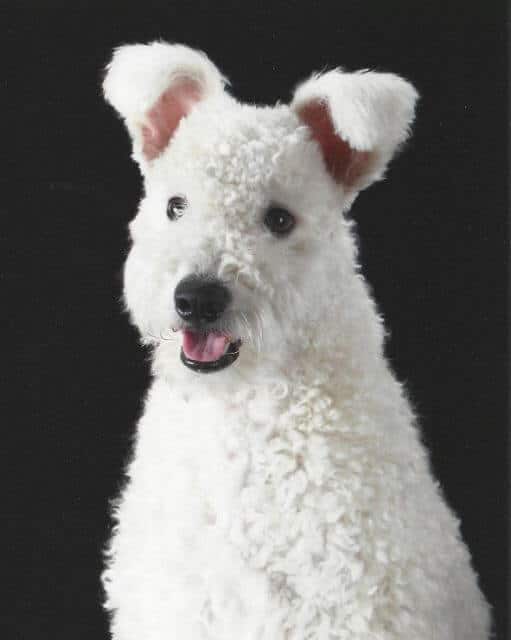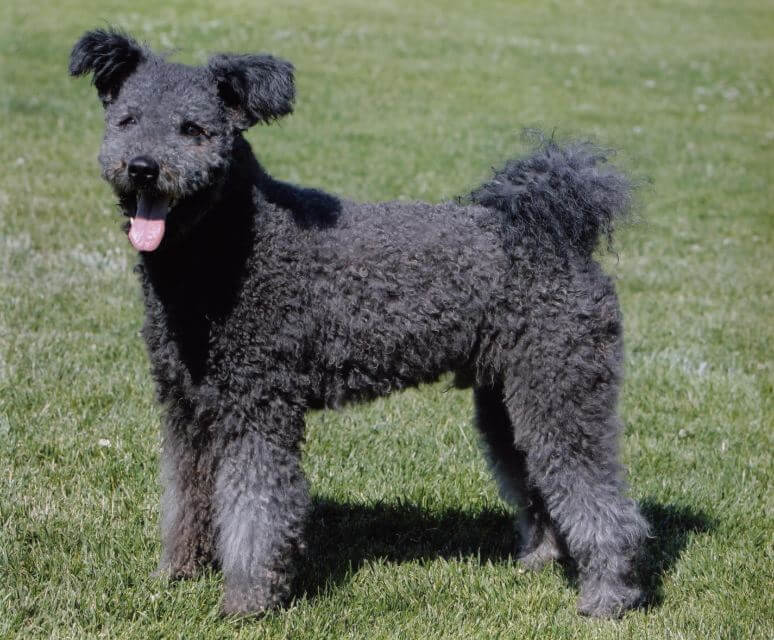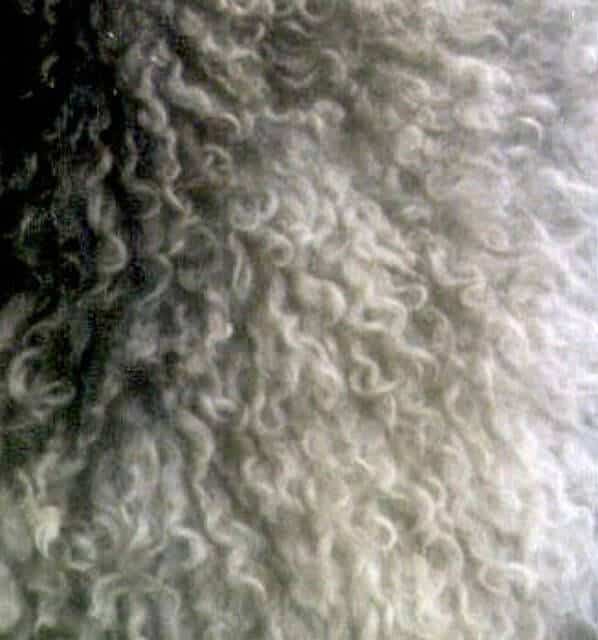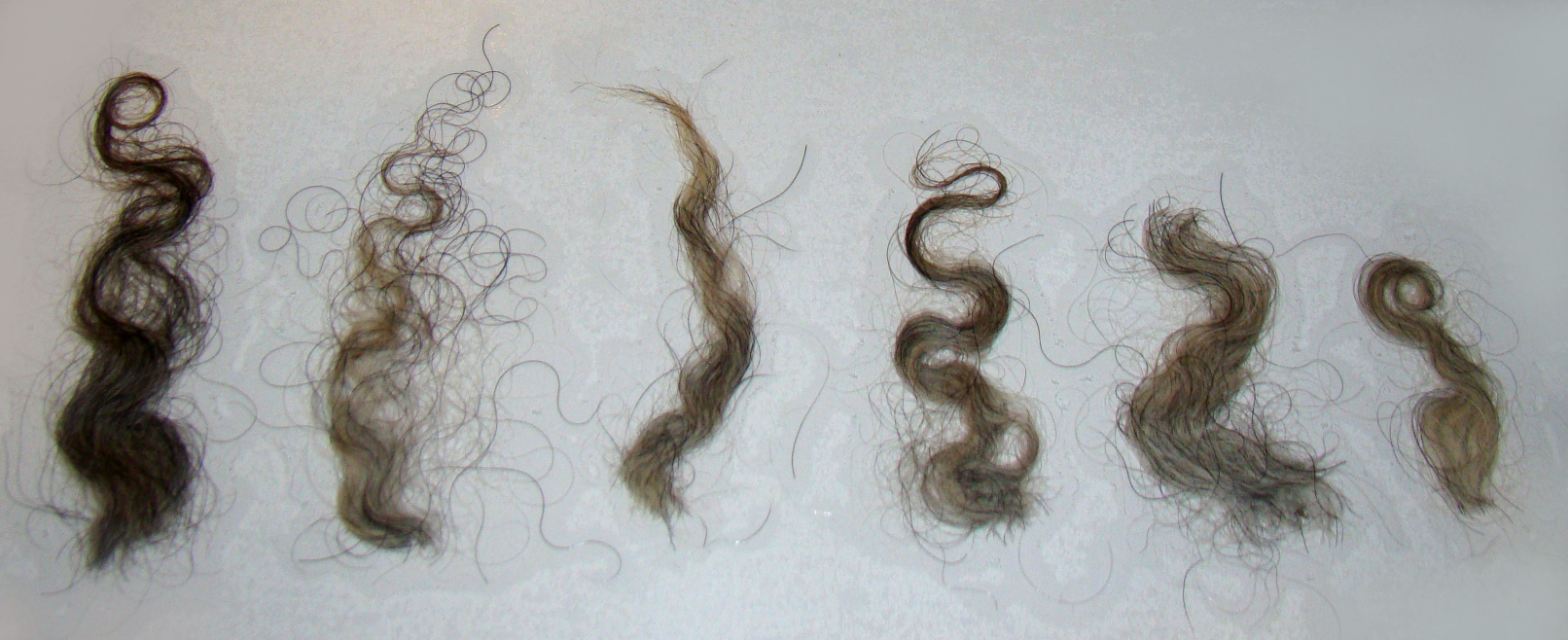
Home » Judging the Pumi

This article was originally published in Showsight Magazine, May 2014 issue.
The Pumi is one of three Hungarian herding breeds, all of similar origin, representing regional variations within Hungary. The Puli originated in the eastern plains, the Mudi in the southern plains, and the Pumi in the hilly Transdanubian region of western Hungary. These breeds are so closely related that even today Pumi-appearing puppies can be born in Puli litters, and Mudi-appearing puppies could be born in Pumi litters. Understanding the close relationship between these breeds will assist a judge in their prioritization of dogs when judging each of these breeds. The three breeds vary the most in coat type, ear shape, and tails. The body types are quite similar, all calling for a square, light-bodied dog.

Head & Ears
The head shape of the Pumi is longer and narrower than the Puli, with the muzzle from 40-50% of the length of the head. The stop is slight compared to the Puli’s which is ‘defined, but not abrupt.’ The standard asks for a ‘full complement’ of teeth, and we ask that judges check the dentition by pulling the lips back to view the sides. If there are any missing teeth (which is not common), it is usually the premolars. The ears are one of the most distinguishing characteristics of the Pumi, and lends to its whimsical expression. The ears are erect, with the top ⅓ of the ear tipped over, the tips pointing slightly to the sides. Judges will see ears from ½ to ¼ tipped over, but the ideal is ⅓. Don’t be fooled by a lot of hair on the ear covering up an erect ear, which is a disqualification. The fold of the ear is not distinct, and is more of a curve than a crease.

Body Shape
The Pumi was used for herding cattle, sheep, and swine. They need to be quick to think and light on their feet, able to change direction instantly. The Pumi is moderately angulated, with moderate reach and drive. The picture should be of a tightly held together square, moving in a very collected manner at a moderate trot. The dogs bond very tightly to their owners, and rarely will show for someone they don’t know. Typically they are cautious of strangers, not backing away, but not going up to them either. This is one reason the Pumi is a table breed. Where they will stand very well for a judge to go over them on the table, they do not appreciate a stranger hovering over them while on the ground. The Pumi is light-bodied, with the depth of chest slightly less than the length of leg. They are like a distance runner—light-bodied and wiry, but with good muscling. The thigh muscling should be surprisingly thick considering the lightness of body. To better see this proportion, see Fig. 2 for a shaved dog.

Coat
The coat is distinct among AKC breeds. It is a mixture of hard and soft hair in a 50-50 proportion. The hard hair and the soft hair are basically the same length. The hair forms into locks of hair which is a distinguishing characteristic of the breed. The hair must never be blown dry and fluffed because it obscures the characteristic coat. The coat is wet down prior to being shown in order to form the curls and locks of hair. These locks of hair vary in type and shape over the body, from curls on the back to corkscrews on the legs. A judge must check for this type of coat, and for the 50-50 proportion of hard and soft hair. The locks of hair do not cord as in the Puli, but can easily be combed out, which they need to have done about once every 2-3 weeks. The hair is surprisingly resilient to dirt and twigs, and what doesn’t fall out, the Pumi will pull out themselves.

Color
The Pumi can be almost any solid color, but always with a black nose and black pigment. The accepted coat colors are black, white, fawn, and any shade of gray. Fawn should preferably have some gray shading in it (i.e. it was also born black and faded to fawn). Gray puppies are born black and fade to gray, the same as the Kerry Blue Terrier and silver Poodle. Because of the graying process, the coat may be a number of shades of gray on the body, typically a bit lighter gray on the legs and muzzle. This shading is not the same as a black and tan pattern which is a disqualification (similar to the phantom Poodle).

Tail
The tail forms a full circle on top of the back of the Pumi, unlike the Puli which blends into the backline, or the sickle of the Mudi. A judge should be able to see daylight in the inside circle of the tail. This type of tail may hang straight when at rest (which is not often), but should always be in a full circle on the move.
What Judges Are Missing
We understand that many times in the Miscellaneous Class, the judge may never have seen the breed before, and it’s the exhibitor’s chance to educate the judges on their breed. I have found that there is a tendency to look for the ‘generic dog’ and miss some of the breed-specific requirements. At first glance, the Pumi should have a Pumi silhouette, or outline. Very square, upright, light-bodied, slightly sloping topline, high tailset, and curled tail, moving at moderate speed with very moderate reach and drive—with a light step and springy (not bouncy) motion. Judges seem to be finding the one with the most reach and drive, which while it satisfies many of the AKC breeds’ requirements, that is not one for the Pumi.

Future Plans
The Pumi was able to enter companion and performance events as of January 2008, and in January 2011 entered the Miscellaneous Class. There are 231 Pumik registered with the AKC Foundation Stock Service (FSS), and 30% of them have obtained 352 AKC titles in obedience, rally, conformation, agility, tracking, coursing, and herding (in addition to non-AKC titles in flyball, freestyle, dock diving, and nose work). The Hungarian Pumi Club of America has provided judges education seminars in most of the main venues, and is willing to provide more as requested, or to answer any questions judges may have about the breed. There is a judges educational CD on the Pumi. Any judges wanting a copy, please contact the author at chris@abiquadogs.com.
